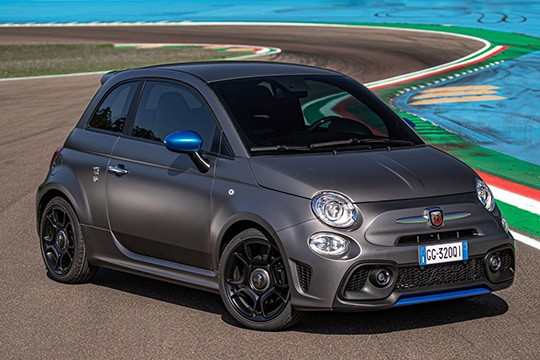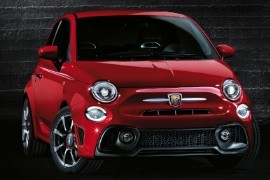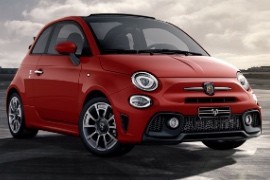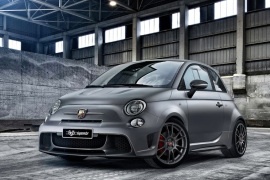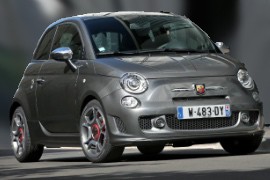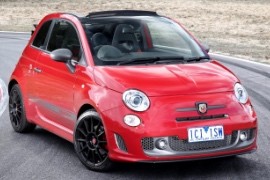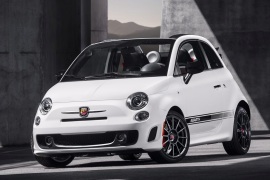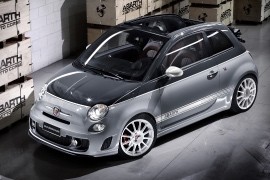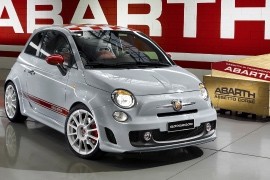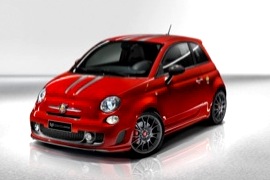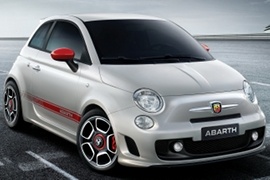FIAT 500 Abarth Models/Series Timeline, Specifications & Photos
First production year: 2008
Engines: Gasoline
Body style: Hatchback
While its electric-powered cousin Fiat 500 conquered the hearts and money of the eco-friendly vehicles buyers, the Abarth 595 version pushed the boundaries of its internal combustion unit.
As part of the Fiat Group, Abarth built its vehicles differently, where the performance factor stood on top of anything else. However, unlike AMG, it didn't focus on luxurious items but turned its attention towards design, technical packages, and a sporty ambiance, even in the small Fiat 500 series.
The Abarth 595 featured a different front fascia than the electric-powered 500. It still sported the round headlights and elliptic lamps underneath them. Still, it sported a functional grille on the lower part of the front bumper, needed to cool the internal combustion engine. It sat between the small, round fog lights. From its sides, the 595 featured 17" light-alloy wheels, while in the back, the carmaker installed a quad exhaust system with twin pipes on each side.
Inside, the car received a mild upgrade with a leather steering wheel and leather Abarth sports seats complemented with black design cues. In addition, the carmaker applied a matte black frame on the 7" HD Uconnect infotainment system, and the same color adorned the dashboard.
But the essential part of any Abarth was under the skin. The 1.4-liter turbocharged engine came from Formula 4 and provided enough grunt for the car to reach a top speed of 135 mph (217 kph) and the 0 to 62 mph (0-100 kph) time in just 7.3 seconds. So along with the stiff suspension and the big brakes kit, it transformed the Abarth 595 into a fun car on tight race tracks.
The little Fiat 500 was sold in over 1.5 million units before it received an ample refresh in 2015. With its charm and a nimble ride, the 500 received numerous updates inside and out.
The Fiat 500 might be called the Fiat brand savior. The charming little car was charming enough to bring back the Fiat brand in the U.S. And it was received as a fashion item more than a transportation device. Despite its small engines and lilliputian size, it fitted well between the big SUVs such as its relatives from RAM. And its powerful Abarth 595 added more grunt to the little car.
The 2016 Fiat 500 Abarth received a new design for the headlights and taillights. It also received LED daytime running lights. The new oversized air intake in the front bumper improved the cooling capacity by 18%. The rear bumper featured a more pronounced diffuser, for better ground effect.
The interior featured new colors and materials, including Alcantara and carbon-fiber trims. The 595 Turismo version was offered with black, tan or red leather seats, while standard on the 595 Competizione was the Corsa by Sabelt sport-bucket seats
The engine bay hosted a 1.4-liter turbocharged engine, but with different power outputs depending on the trim level. The 595 and 595 Turismo versions were offered with 145 hp and 160 hp, respectively, while the 595 Competizione (Racing) was boosted up to 180 hp. The standard gearbox for all Abarth 595 was a 5-speed manual, and a 5-speed auto was available at extra cost.
When the 500 595 Abarth range was refreshed in 2015, its convertible sibling was updated as well. Thus, the canvas-top pocket-rocket was ready to roam the streets under the open sky.
The Fiat 500 might be called the Fiat brand savior. The charming little car was charming enough to bring back the Fiat brand in the U.S. And it was received as a fashion item more than a transportation device. Despite its small engines and lilliputian size, it fitted well between the big SUVs such as its relatives from RAM. And its powerful Abarth 595 added more grunt to the little car.
The 2016 Fiat 500C Abarth received a new design for the headlights and taillights. It also received LED daytime running lights. The new, oversized, air intake in the front bumper improved the cooling effect by 18%. The rear bumper featured a more pronounced diffuser, for better ground effect.
The interior featured new colors and materials, including Alcantara and carbon-fiber trims. The 595C Turismo version was offered with black, tan, or red leather seats, while the Corsa sport-bucket seats by Sabelt were standard on the 595C Competizione.
The engine bay hosted a 1.4-liter turbocharged engine, but with different power outputs depending on the trim level. The 595 and 595 Turismo versions were offered with 145 hp and 160 hp, respectively, while the 595 Competizione (Racing) was boosted up to 180 hp. The standard gearbox for all Abarth 595 was a 5-speed manual, and a 5-speed auto was available at extra cost.
In 2014, at Geneva Motor Show, Fiat unveiled a track-focused, race-breed small hatchback: the 695 Abarth Biposto, a hot-hatch developed for those who were not afraid to race on weekends but on a lower budget.
Unveiled half a century after the original Abarth 595 and in the same location, the new model came with bolt-on upgrades for the small-sized Fiat 500. But the result exceeded everyone's expectations. Moreover, while other automakers tried to impress with compact-sized hot hatches, Fiat did that successfully with a smaller vehicle.
Abarth was already known for its packages available to upgrade the tiny 500, but this version was something else. The exterior featured carbon fiber bumpers and a rear wing. The 18" OZ wheels were different than the standard ones fitted on the regular 500, allowing bystanders to admire the replacement Brembo brake kits. In addition, thanks to the improved suspension, the ground clearance was lowered to emphasize the car's sporty look. Last but not least, the Akrapovich dual exhaust peaked in the back, flanking the diffuser.
Inside, customers could opt for carbon-fiber seats, trims, and a titanium roll-cage. The rear seats were deleted, hence the Biposto (two-seat) designation. There were also options for an improved LCD-based speedometer and data-log tracker for those looking to race this little hot hatch.
But the most essential upgrade was found under the hood, where Abarth engineers managed to squeeze 190 PS (189 hp) from the 1.4-liter turbocharged engine.
The sporty car was inspired by the history 595 model, released in 1963. The Abarth 595 was highly anticipated when it was released in 2012.
The exterior design of the Abarth was pretty much the same, with the exception of side skirts that were redesigned for better aerodynamics and the front bumper with large air vents. The specifc Abarth logo was also present on one side.
Inside the small Abarth you could find a nice combination of leather colors, with a unique flat-bottomed steering wheel, all wrapped up in leather with nice stitchings on the inside.
The sporty seats were manually adjustable and offered good comfort for the front passengers, while the nicely designed rear seats were a match for short people only, due to no headroom and reduced legroom.
The 1.4-liter 4-cylinder engine developed 160, and while it might not sound like a lot, the Abarth was a light car, and the combination of power and weight made it a fast vehicle.
The engine was mated to a 5-speed manual transmission, the only option available for this model.
The Abarth 595 offered halogen headlamps, alloy wheels, a faster electrically assisted power steering, power mirrors and even a fully powered sunroof.
Different systems could be controlled through the voice commands available in the owner’s manual, such as playing music from media or radio.
With its long racing pedigree behind it, the Italian race-engineering company Abarth took the little Fiat 500 and transformed it into a mini hot-hatch, then it took its roof off to make the 595C model.
Back in 1963, Carlo Abarth took a standard Fiat 500 and tuned it. He increased the displacement up to 593 cc, named it 595, and then tuned the engine to provide 35 hp. It was more than enough for the light vehicle to provide more speed and, thanks to a lowered and stiffened suspension, to get faster around a track than the standard 500. In respect for that racing version, Fiat and Abarth met again, this time for the modern 500.
On the outside, the car featured a new aerodynamic package that showed a lowered apron at the front with a wide grille in the middle and two side scoops. Between the scoops and the center element, Abarth stuck the fog-lights. On the sides, the rocker-panels were lower and had a minor aerodynamic ground-effect. The main difference between the 595 and the 595C was the roof. While the regular version featured a fixed, metallic roof, the C-version sported a folding top, which could have been retracted behind the rear bench, above the trunk area.
Inside, the carmaker installed two sport seats at the front with integrated headrests. In the back, the bench was profiled for two. When it made the open-top version, Fiat took care not to take more room from the already small interior. The dash panel color matched the hand-stitched leather-clad interior. The carmaker included a sport steering wheel with a flattened bottom in the package.
Under the hood, Abarth took the 1.4-liter turbocharged engine and worked its magic. There were two output versions: 160 hp and 180 hp.
Fiat relentlessly worked on its best-selling model, the 500, and improved it in any possible way it could, and that included a rag-top version for the punchy Abarth version.
Abarth was known for creating some of the most powerful and sporty versions of the Fiat. They were responsible for creating racing cars for the Italian automaker. In addition, it was also involved in upgrading Fiat production vehicles such as the Stilo or the Bravo. But then, the carmaker had a different idea: to involve it in the development of the 500 lineup, and the result was a pocket rocket that was available with either a hard roof or a retractable rag-top.
The Fiat 500C’s exterior didn’t have any Fiat badges on it, just those that showed the “Scorpione” (scorpion) one, specific for the Abarth brand. The regular front fascia of the Italian little car was transformed, and the lower bumper was replaced with one that featured a broad air intake on the lower side of the air dam. Also, there were the round fog lamps and, on the sides, a pair of decorative scoops. From its profile, the 500C boasted red calipers for both front and rear brake discs, plus redesigned side sills. The back of the car was also improved in terms of styling and received a new bumper with side vents and, underneath it, two oval exhausts integrated into the diffuser. Unlike the rest of the 500 range, the Abarth was available with a choice of 16” or 17” light-alloy wheels.
Inside, despite the car’s small size, the automaker found a way to provide enough room for the front occupants. Both the driver and their side passenger sat on high bolstered seats with tall seatbacks and integrated headrests. There were no significant changes in the instrument cluster, but Abarth added a tachometer mounted on the steering column. Other enhancements were visible on the flat-bottom steering wheel, which was decorated with the same “Scorpione” badge as the vehicle’s exterior. On the center console, the 500C featured the gear stick, which Abarth adorned with a new gear knob with red markings. In front of the passenger, the automaker placed the 500C lettering on the dash panel, which sported the same color as the car’s exterior. In the back, there was hardly room for passengers, although, with the roof retracted behind it, it was slightly better.
Under the hood, Abarth added a turbocharger to the 1.4-liter engine of the vehicle and raised its power to 160 hp (162 PS), which helped the little vehicle have a zero-to-sixty run in less than eight seconds. In addition, thanks to the stiffer suspension and improved brakes, the Fiat 500 Abarth was transformed into a pocket rocket.
Ever since the first generation of the 500, Fiat offered a top-cabriolet version for the little city car, and it generously offered it with a rag-top even on the sportiest versions.
Fiat and Abarth are linked together like M from BMW and AMG from Mercedes-Benz. There was no surprise that the Italian specialist tuned the 500 series into a stylish pocket-rocket that could roam the streets with its 160 hp turbocharged engine.
Abarth worked for the Italian carmaker and tuned the 1.4-liter engine to produce more power, but it didn't forget to restyle the car's exterior. Unlike the rest of the Fiat 500 range, it featured a lower apron at the front with a big mesh-grille and two fog-lights. On the outer sides, the tuner prepared two vents for the disc-brakes. The modifications went on and prepared a set of aerodynamic side-sills. To complete the sporty image, Abarth installed a roof-spoiler between the C-pillars. As with any 500 top-cabriolet, the 500C Abarth Essesse featured a power-retractable fabric roof folded down behind the rear seats, together with that spoiler.
Inside, Abarth changed the dashboard and mounted a boost-gauge next to the instrument cluster. The red metallic panel resembled the shape of the original Fiat 500 from the '50s. Instead of a gear-lever, the carmaker installed four buttons on the center stack to control the gearbox. If the driver desired to change them manually, he or she could use the steering wheel's paddle shifters.
Under the hood, Fiat dropped a 1.4-liter turbocharged engine that produced, with the Abarth help, a whopping 160 hp, which were sent to the front wheels via a five-speed automatic transmission.
Fiat brought back the Abarth nameplate on the market and gave it a toy to handle: the supermini 500 model, which under the "Scorpione" badge, developed more ponies to play with.
The "Esseesse" means in Italian what SS means for American muscle cars: Super Sport. While it might sound funny for such a small vehicle to have that kind of badge, it was well deserved. With its punchy engine under the hood and the light weight of the car, the 500 Abarth esseesse offered an excellent power-to-weight ratio.
At first, Abarth offered a package that came in a wooden box so owners could retrofit their vehicles with performance parts provided by the automaker. Customers liked the idea, and the automaker later on offered factory-produced these esseesse vehicles. The car's front fascia looked different, with a broad lower air intake fitted in the bumper, and the fog lights were mounted there as well. On the sides, in front of the front wheels, Abarth placed a set of air intakes to cool the brakes, which were also upgraded and could be seen through the 17" light-alloy wheels. Finally, at the back, the automaker added a roof spoiler at the top of the tailgate and a pair of exhausts that flanked a center diffuser under the bumper. Last but not least, the car sported the "Scorpione" (Scorpion in Italian) badges on the front and rear fascias instead of Fiat's ones.
Inside, the automaker mounted a set of high-bolstered bucket seats with integrated headrests at the front, featuring unique upholstery. The black leather and red stitching were typical for Abarth vehicles, and the 500 also sported those specific elements. In the back, like in any other Fiat 500, there was room enough only for a purse. It could hardly fit two people in there.
Under the hood, the automaker installed its 1.4-liter turbocharged gasoline engine paired with a five-speed manual gearbox that sent its power to the front wheels. As part of the package, the car was also fitted with stiffer suspension than the regular Fiat 500.
While it might be still considered a mere Fiat 500, the Abarth 695 Tributo Ferrari was a special, limited series that provided more excitement for the little Italian car.
Abarth and Ferrari had a history together, and after they shared the same roof under Fiat group, it wasn't long before the three brands joined into a common project. While it couldn't be made a Ferrari with a Fiat badge on it, the best solution was to take Fiat's most wanted car, the 500, ask Abarth to tune it, and then add some Maranello spices on it. The result was the 500 Abarth 965 Tributo Ferrari.
At a glance, it was the same 500 that rattled inside cities with its tiny headlights and flashy color. But it was more than that. It featured a lowered front bumper, aerodynamically profiled side sills, and a different rear bumper. The 17" light-alloy wheels were definitely something else than on any other city vehicle around. It wasn't a maxi-500; it was a mini-Ferrari. Its two gray stripes on the hood matched the color from the apron's accents. And the stripes went on over the car and onto the tailgate.
Inside, Abarth installed high-bolstered sport bucket-seats upholstered in Alcantara. The dashboard featured carbon-fiber accents, and the thick steering wheel was different than in any other Fiat. There was no gear-stick on the center stack, just a few buttons to select the gearbox program. In addition to those, Abarth installed a pair of paddle shifters behind the steering wheel for the driver to manually change gears.
Under the hood, a 1.4-liter turbocharged gasoline engine provided 180 hp in a car that was just a little bit longer than a SMART ForTwo. Thanks to its tuned suspension, tweaked brakes, and fat tires, it was one of the best city hot-hatches on the market and priced more than any other Fiat from that time.
Fiat introduced the Abarth version of the 500 at the 2008 Geneva Motor Show as a pocket-rocket city car developed for fun.
The world financial crisis was about to begin in Europe. It was already known in the North American market, and Fiat definitely knew what would follow. And yet, it didn't back up and still offered this pumped-up version of the 500, and it did that in cooperation with Abarth, the company's motorsports specialist. The idea of re-connecting the Abarth with the 500 was made due to the success recorded by the 1960s 500 Abarths in races.
While the main body panels were left untouched, the front bumper was new, sporting a broad air intake in the middle flanked by two functional side scoops. Their role was to divert the air to the sides of the car and improve aerodynamics. From its profile, the little 500 Abarth boasted its 16" light-alloy wheels. In addition, the side skirts created an even sportier image of the car, while at the back, a wing adorned the top of the tailgate. Last but not least, the automaker added a new rear bumper that hosted the dual exhausts with chromed tips. More importantly, though, was that the automaker agreed to install Abarth front and rear logos instead of Fiats' round badges.
Inside, Abarth installed a pair of sport bucket seats at the front. They offered excellent side support due to their bolstering. In addition, the motorsport specialist added a flat-bottom steering wheel and a set of aluminum pedals.
But the most essential upgrade was under the hood. There, Abarth worked on the small 1.4-liter turbocharged engine and squeezed 135 ponies from it. All the oomph went to the front wheels via a six-speed manual and was tamed with the help of a new electronically controlled differential.
